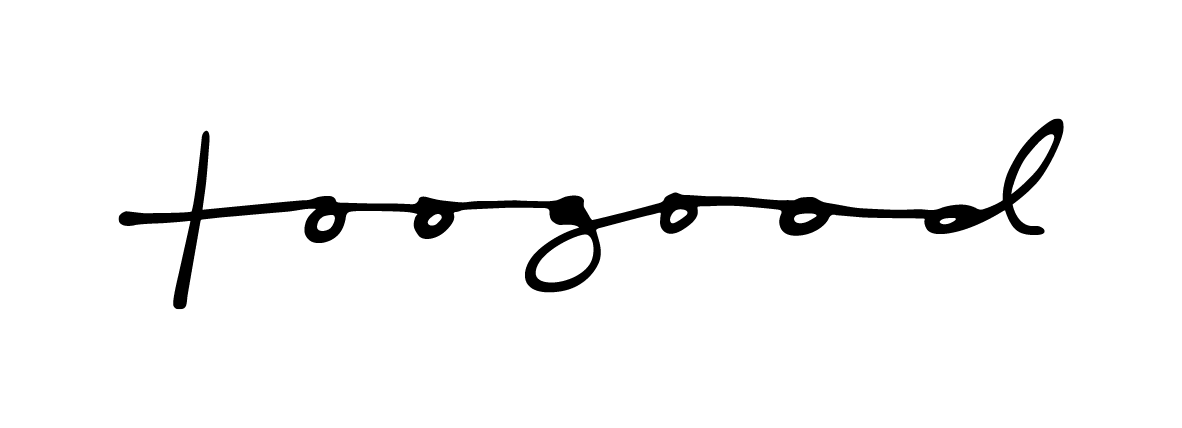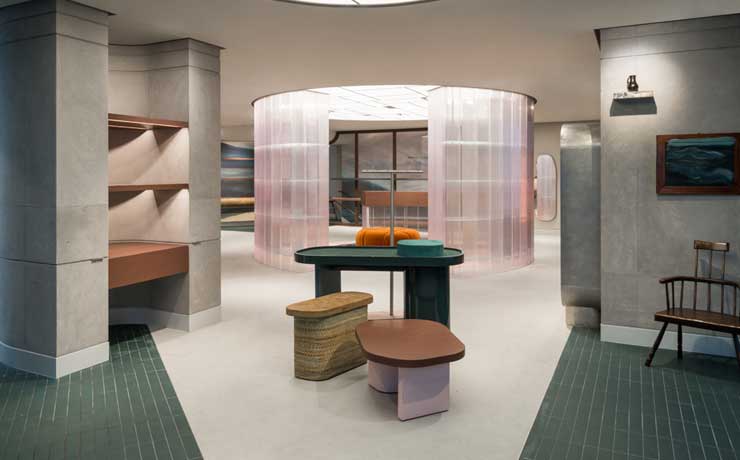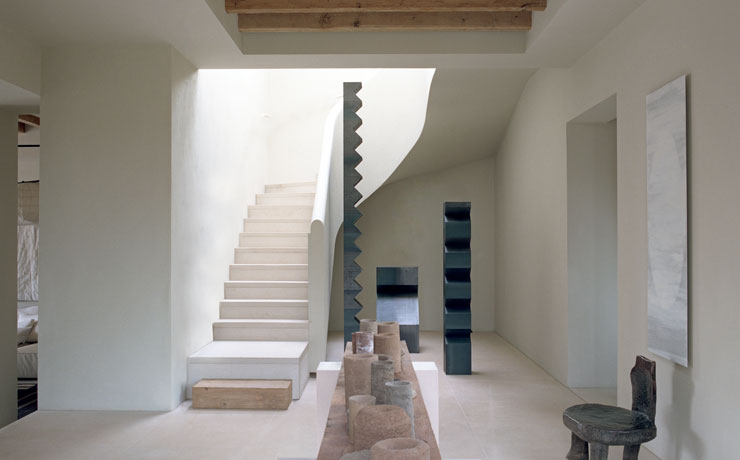Spring/Summer 2019
CEREAL
Sisterhood
Words: Hugo Macdonald
Photography: Iringo Demeter
You might describe the Toogood sisters as accidental revolutionaries. They grew up in Rutland, one of England’s smaller counties. Faye studied art history before embarking on a career as a stylist, first for World of Interiors, and then, under her own name, she founded Studio Toogood in 2008 to explore “object, sculpture, and space” with greater attention. Erica is a pattern cutter by training and trade. She worked behind the scenes in the fashion and textile world, from couture to theatre. They describe themselves as the tinker and tailor, respectively. Together, in 2013, the sisters founded Toogood, channelling their collective vision through the medium of clothing. 11 collections later, they have achieved cult status, yet remain true to their original dictum that fashion is a craft to celebrate individual expression. They work together in the House of Toogood on Redchurch Street, in east London.
What impact does being sisters have on your working process?
Erica: It helps us to be brave.
Faye: ‘Brave’ is an important word for us. When you’re growing up together, you have a natural synergy. There’s five years’ difference between us, and, to some extent, we had quite a difficult relationship as children. In terms of developmental phases, we always seemed to be in different places at different times.
E: Whenever one of us was thriving, the other would be going through a bit of an awkward patch.
F: In our 20s we came together as independent individuals, and started to be sisters in a way we hadn’t been before.
How did you begin working together?
F: The main catalyst for Toogood was a project called Seven Designers for Seven Dials, which took place during the 2012 London Design Festival in Covent Garden. We celebrated traditional UK trades that no longer exist in the area by hanging 49 oversized, two-and-a-half metre high coats in the street. Each one had a giant metal label hanging out of it stating the trade it was celebrating.
E: We cut the coats so they had creases in the arms and the pockets fell forward, as though the tradespeople had already worn them. We made all 49 coats on one sewing machine in our studio out of bathroom blind fabric, then we cleared an area where Faye painted them all with industrial paint.
F: This project galvanised us. We were struck by the notion of trades, and the realisation that we are losing so much knowledge and skill. We had previously discussed combining Erica’s pattern cutting with my work to elevate UK craftsmanship.
E: It was out of these ideas that our first Toogood collection came to life, consisting of eight coats representing eight trades, including the road sweeper, the oil rigger, the beekeeper, and the milkman. We took the collection to Paris where it struck a nerve. A few seasons later, we’ve ended up with over 50 stockists.
Is a sense of nostalgia inherent in utility wear?
F: Designers find ‘nostalgia’ a difficult word. But, luckily, I didn’t train as a designer, so I don't have quite the same problem with it. For me, references from the past — recut, reshuffled and re-edited — are relevant. Without them, it’s difficult to create or trigger emotional responses. It’s very different from something being ersatz or pastiche. I have true respect for Erica in that she cuts every pattern from scratch, instead of modelling her garments on vintage pieces and only making minor adjustments. Figuring out what makes archetypal clothing is labour intensive work.
E: Faye gives me courage to explore. When we started, she always challenged me by asking me questions like: “Why do you have to have that seam on that shoulder?” When I explained that it held everything up, she asked me if there might be another way to do it.
Why do you think the unisex aspect of your garments has captured people’s imagination?
E: It feels very contemporary, but, for us, it was a natural result of our process. In the beginning, we didn’t even consider the question of whether our clothes were menswear or womenswear.
F: We wanted to dress women and men, our parents, our friends, artists, architects — all the people we knew who didn’t want to be wearing labelled fashion. Gender never came into it. It was purely by chance that we hit on the poignant question of whether men and women would be able to wear the same clothes as one another.
Your expression of provenance is equally timely ...
E: Transparency is fundamental. Each garment has its own ‘passport’ inside, which gives the names of the designers, the makers, the cutters, the seamstress, the presser, and the hand finisher. It also records the fact that the garment was made in London. We feel that this transparency in our process makes our pieces human and legitimate.
How do you communicate throughout your process?
F: We describe it as a silent conversation. As children, we played in different areas of the room, and then only came together at certain points. It’s my job to formulate the concept, and then visualise the finished garments as a collection. Erica, meanwhile, is busy with fabrics, buttonholes, the shape of a sleeve. I’m present at the beginning and the end, and Erica joins the whole thing together. Just as we were when we were children, we only play together in the middle of the room at certain points during the process.
E: We give each other space and respect. We each have our own areas and roles.
F: Erica has her pattern cutting studio upstairs at the top of the house, but I don’t have a desk. I run around in different parts of the studio. I don’t like emails or sitting down. My process is so much in my head, and bound up in references and imagery, which shift and merge to form a concept. Erica is immediately at the cloth with scissors. There’s very little sketching that goes on.
E: We don’t have a team of designers drawing 150 versions of a jacket a day. It’s a scribble on a piece of paper at the end of the table to share ideas, and then we start. We trust what the other is thinking, so it doesn’t need to be a fraught or time consuming process.
F: Our barometer for a garment is whether Erica or myself would wear it. If neither of us would wear it, it doesn't go in. Too many designers are bound by external, market-driven factors rather than human ones. We know that we’re dressing the people we want to dress.
E: This is why our clothing feels real. Our design happens in 3D — we chop and change a toile on Faye and pin it into position. In Paris, for our first couple of seasons, we were the models. We sat prospective clients on the sofa and ran back and forth behind a curtain, trying on different things to show them. Those stockists are still with us today. They loved the process of two sisters running around trying on coats. It was unpretentious.
F: We will always be outsiders. We sit outside the fields of furniture, product, art, interiors, and fashion, but we partake in all of them. We do things in a way that makes sense to us.
E: We captured the imagination. People understood where we were coming from, and they were open to seeing something genuine.
F: We strive to do everything from a genuine place. Otherwise we’re just giving form to fabric on a hanger. When there’s genuine care and intent in a process, people connect to the finished product. Connecting to things is what we exist for, be it something you’re wearing, something you’re sitting on, the room that you’re sitting in, or the food that you’re eating.
How do you hope people connect with your clothing?
E: It’s important that the wearer is a part of the process. They are just as important as the designer, the cutter, or the seamstress. That means that they also have the responsibility to take the garment on and make it their own. We leave a space for the wearer to write their own initials at the bottom of the passport inside each garment, so they feel like they own it. It becomes part of them. Or if you inherit it from your sister, you can scrub out her initials, and write your own. And then it becomes part of you.


